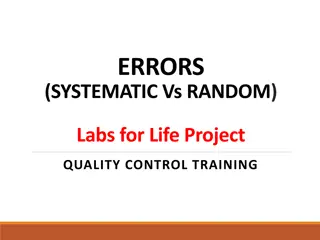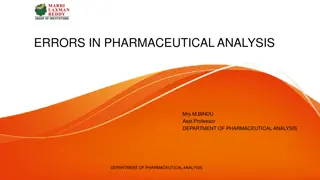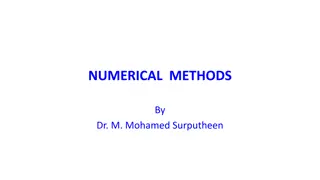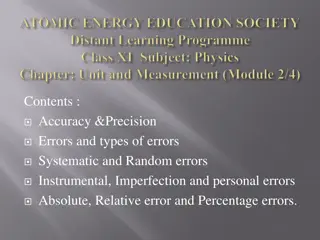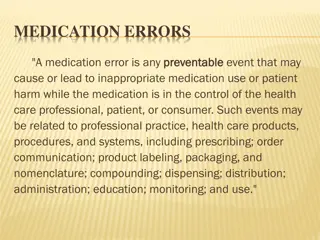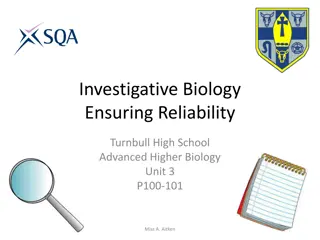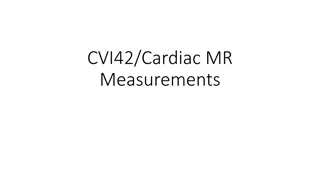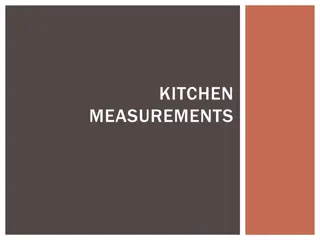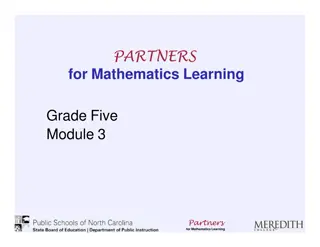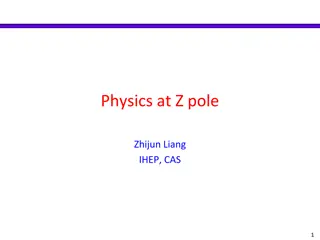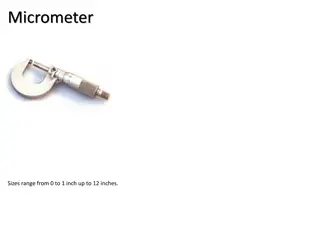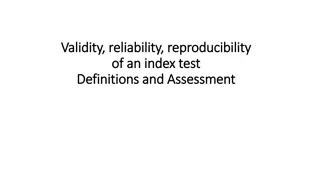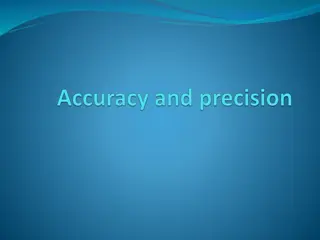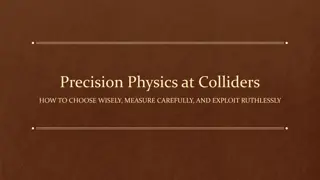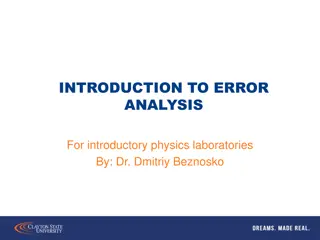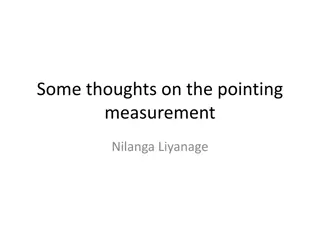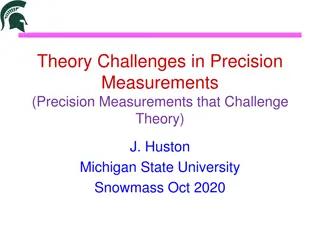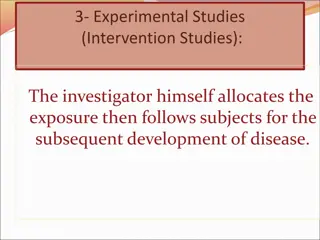Measuring Errors and Precision in Experimental Measurements
In Chapter 1, the focus is on uncertainties in measurements, distinguishing between errors and mistakes, systematic and random errors, and the importance of accuracy and precision in experimental results. The chapter discusses techniques to reduce errors and improve precision, with examples illustrating the concepts.
Download Presentation

Please find below an Image/Link to download the presentation.
The content on the website is provided AS IS for your information and personal use only. It may not be sold, licensed, or shared on other websites without obtaining consent from the author.If you encounter any issues during the download, it is possible that the publisher has removed the file from their server.
You are allowed to download the files provided on this website for personal or commercial use, subject to the condition that they are used lawfully. All files are the property of their respective owners.
The content on the website is provided AS IS for your information and personal use only. It may not be sold, licensed, or shared on other websites without obtaining consent from the author.
E N D
Presentation Transcript
CHAPTER 1 UNCERTAINTIES IN MEASUREMENTS
1.1 MEASURING ERRORS For all physical experiments, errors and uncertainties makes an experimental value different from true value. The errors and uncertainties must be reduced through improved experimental techniques and repeated measurements. Difference between errors and mistakes. Errors are inherent in the measuring techniques and require special methods for their elimination or reduction. Mistakes generally are due to some form of carelessness on the part of the experimenter. Error: the difference between an observed /calculated value and the true value. True value is not precisely known but can be estimated from earlier experiments or from theoretical predictions. Mistakes (Illegitimate errors) : errors that originate from mistakes or blunders in measurement or computation. They are incorrect data points /results and are not reasonably close to expected values. They can be corrected by carefully repeating the operations. Types of errors : Systematic Errors and Random Errors: Systematic Errors and Random Errors limit the precision and accuracy of our results in more or less well-defined ways.
Accuracy Versus Precision Accuracy : How close the result of the experiment is to the true value; Precision: How well the result has been determined, without reference to its agreement with the true value. Precision : a measure of the reproducibility of the results. Figure 1.1 shows two sets of measurements. The straight line on each graph shows the expected relation between the dependent variable y and the independent variable x. In both graphs, the scatter of the data points is a reflection of uncertainties in the measurements, consistent with the error bars on the points. The data in Figure 1.1(a) have been measured to a high degree of precision as shown by the small error bars, and are in excellent agreement with the expected variation of y with x, but are clearly inaccurate, deviating from the line by a constant offset. the data points in Figure 1.1 (b) are rather imprecise as shown by the large error bars, but are scattered about the predicted distribution. Accuracy and precision must be considered simultaneously for any experiment. To determine a result with high precision and high inaccuracy is a waste of time and energy Conversely, a result cannot be extremely accurate if the precision is low. uncertainty or error in a result is referred to the precision with which that result has been determined. Absolute precision : magnitude of the uncertainty in the result expressed in the
Systematic Errors They may result from faulty calibration of equipment or from bias on the part of the observer. They must be estimated from an analysis of the experimental conditions and Techniques. Errors of this type are not easy to detect and not easily studied by statistical analysis. A major part of the planning of an experiment should be devoted to understanding and reducing sources of systematic errors. EXAMPLE 1.1 A student measures a table top with a steel meter stick and finds that the average of his measurements yields a result of (1.982 O.OOl) m for the length of the table. He subsequently learns that the meter stick was calibrated at 25 C and has an expansion coefficient of 0.0005 e-l. Because his measurements were made at a room temperature of 20 C, they are systematically too small. To correct for this effect, he multiplies his results by 1 + 0.0005 X (20 - 25) = 0.9975 so that his new determination of the length is l.977 m. When the student repeats the experiment, he discovers a second systematic error, his technique for reading the meter stick was faulty in that he did not always read the divisions from directly above. By experimentation he determines that this consistently resulted in a reading that was 2 mm short. The corrected result is l.979 m. In this example, the first result was given with a fairly high precision, approximately
Systematic Errors Errors caused due to faulty calibration of equipment or from bias on the part of the observer. They can be estimated from an analysis of the experimental conditions and techniques. Systematic Errors cannot be studied by statistical analysis. Reduction of systematic errors : major part of the planning of an experiment.
EXAMPLE 1.1 A student measures a table top with a steel meter stick and finds that the average of his measurements yields a result of (1.982 0.001) m for the length of the table. Meter stick was calibrated at 25 C and has an expansion coefficient of 0.0005 e-1. The measurements were made at a room temperature of 20 C, they are systematically too small. To correct, he multiplies his results by 1 + 0.0005 X (20 - 25) = 0.9975 so that his new determination of the length is 1.977 m. When the student repeats the experiment, he discovers a second systematic error, his technique for reading the meter stick was faulty in that he did not always read the divisions from directly above. By experimentation he determines that this consistently resulted in a reading that was 2 mm short. The corrected result is l.979 m. In this example, the first result was given with a fairly high precision, approx. 1 part in 2000. The corrections to this result were meant to improve the accuracy by compensating for known sources of deviation of the first result from the best estimate possible. These corrections did not improve the precision at all, but did in fact worsen it, because the corrections were themselves only estimates of the exact corrections. Before quoting his final result, the student must reexamine his error analysis and take account of any additional uncertainties that may have been introduced by these corrections.
Random Errors The precision of an experiment depends upon random errors, caused by fluctuations in observations that yield different results each time the experiment is repeated, and thus require repeated experimentation to yield precise results. A given accuracy implies an equivalent precision and, therefore, also depends to some extent on random errors. The problem of reducing random errors is essentially one of improving the experimental method and refining the techniques, as well as simply repeating the experiment. If the random errors result from instrumental uncertainties, they may be reduced by using more reliable and more precise measuring instruments. If the random errors result from statistical fluctuations in a limited number of measurements, they may be reduced by making more measurements. There are practical limits to these improvements. In the measurement of the length of the table of Example 1.1, the student might attempt to improve the precision of his measurements by using a magnifying glass to read the scale, or he might attempt to reduce statistical fluctuations in his measurements by repeating the measurement several times. In neither case would it be useful to reduce the random errors much below the systematic errors, such as those introduced by the calibration of the meter stick or the correction for his initial faulty reading of the scale.
Random Errors random errors : caused by fluctuations in observations that yield different results each time the experiment is repeated. Precision of an experiment depends upon random errors Random error can be minimized through repeated measurements to yield precise results. A given accuracy implies an equivalent precision and, therefore, also depends to some extent on random errors. Reducing random errors: requires improving the experimental method and techniques, as well as repeating the experiment. Random errors resulting from instrumental uncertainties: may be reduced by using more reliable and more precise measuring instruments. Random errors resulting from statistical fluctuations in a limited number of measurements: they may be reduced by making more measurements. There are practical limits to these improvements. In the measurement of the length of the table of Example 1.1, the student might attempt to improve the precision of his measurements by using a magnifying glass to read the scale, or he might attempt to reduce statistical fluctuations in his measurements by repeating the measurement several times. It would not be useful to reduce the random errors much below the systematic errors, such as those introduced by the calibration of the meter stick or the correction for his initial faulty reading of the scale. The limits imposed by systematic errors are important considerations in planning
Significant Figures and Roundoff The precision of an experimental result is implied by the number of digits recorded in the result, although generally the uncertainty should be quoted specifically as well. The number of significant figures in a result is defined as follows: 1. The leftmost nonzero digit is the most significant digit. 2. If there is no decimal point, the rightmost nonzero digit is the least significant digit. 3. If there is a decimal point, the rightmost digit is the least significant digit, even if it is a O. 4. All digits between the least and most significant digits are counted as significant digits. For example, the following numbers each have four significant digits: 1234, 123,400, 123.4, 1001, 1000., 10.10,0.0001010, 100.0. If there is no decimal point, there are ambiguities when the rightmost digit is O. Thus, the number 1010 is considered to have only three significant digits even though the last digit might be physically significant. To avoid ambiguity, it is better to supply decimal points or to write such numbers in scientific notation, that is, as an argument in decimal notation multiplied by the appropriate power of 10. Thus, our example of 1010 would be written as 1010. or 1.010 X 103 if all four digits are significant.
Significant Figures and Roundoff The precision of an experimental result is given by the number of digits recorded in the result. Rules of significant figures in a number: 1. The leftmost nonzero digit is the most significant digit. 2. If there is no decimal point, the rightmost nonzero digit is the least significant digit. 3. If there is a decimal point, the rightmost digit is the least significant digit, even if it is a 0. 4. All digits between the least and most significant digits are counted as significant digits. For example, the following numbers each have four significant digits: 1234, 123,400, 123.4, 1001, 1000., 10.10,0.0001010, 100.0. If there is no decimal point, there are ambiguities when the rightmost digit is 0. Thus, the number 1010 is considered to have only three significant digits even though the last digit might be physically significant. To avoid ambiguity, it is better to supply decimal points or to write such numbers in scientific notation, that is, as an argument in decimal notation multiplied by the appropriate power of 10. Thus, our example of 1010 would be written as 1010. or 1.010 X 103 if all four
To round off a number to fewer significant digits than were specified originally, we truncate the number as desired and treat the excess digits as a decimal fraction. Then: 1. If the fraction is greater than 1/2, increment the new least significant digit. 2. If the fraction is less than 1/2, do not increment. 3. If the fraction equals 1/2, increment the least significant digit only if it is odd. The reason for rule 3 is that a fractional value of 1/2 may result from a previous rounding up of a fraction that was slightly less than 1/2 or a rounding down of a fraction that was slightly greater than 1/2. For example, 1.249 and 1.251 both round to three significant figures as 1.25. If we were to round again to two significant figures, both would yield the same value, either 1.2 or 1.3, depending on our convention. Choosing to round up if the resulting last digit is odd and to round down if the resulting last digit is even, reduces systematic errors that would otherwise be introduced into the average of a group of such numbers. Note that it is generally advisable to retain all available digits in intermediate calculations and round only the final results. 1.2 UNCERTAINTIES Uncertainties in experimental results can be separated into two categories: those that result from fluctuations in measurements, and those associated with the theoretical description of our result. For example, if we measure the length of a rectangular table along one edge, we
Round off When insignificant digits are dropped from a number, the last digit retained should be rounded off for the best accuracy. To round off a number to fewer significant digits than were specified originally, we truncate the number as desired and treat the excess digits as a decimal fraction. Then: 1. If the fraction is greater than 1/2, increment the new least significant digit. 2. If the fraction is less than 1/2, do not increment. 3. If the fraction equals 1/2, increment the least significant digit only if it is odd. The reason for rule 3 is that a fractional value of 1/2 may result from a previous rounding up of a fraction that was slightly less than 1/2 or a rounding down of a fraction that was slightly greater than 1/2. For example, 1.249 and 1.251 both round to three significant figures as 1.25. If we were to round again to two significant figures, both would yield the same value, either 1.2 or 1.3, depending on our convention. Choosing to round up if the resulting last digit is odd and to round down if the resulting last digit is even, reduces systematic errors that would otherwise be introduced into the average of a group of such numbers. Note that it is generally advisable to retain all available digits in intermediate calculations and round only the final results.
1.2 UNCERTAINTIES Uncertainties in experimental results can be separated into two categories: Those that result from fluctuations in measurements, and those associated with the theoretical description of our result. If we were to measure the length of the table at equally spaced positions across the table, the measurements would show additional fluctuations corresponding to irregularities in the table itself, and our result could be expressed as the mean length. If, however, we were to describe the shape of an oval table, we would be faced with uncertainties both in the measurement of position of the edge of the table at various points and in the form of the equation to be used to describe the shape, whether it be circular, elliptical, or whatever. Thus, we shall be concerned in the following chapters with a comparison of the distribution of measured data points with the distribution predicted on the basis of a theoretical model. This comparison will help to indicate whether our method of extracting the results is valid or needs modification. The term error suggests a deviation of the result from some "true" value. Usually we cannot know what the true value is, and can only estimate the errors inherent in the experiment. If we repeat an experiment, the results may well differ from those of the first attempt. We express this difference as a discrepancy between the two results.
1.2 UNCERTAINTIES Uncertainties in experimental results can be separated into two categories: those that result from fluctuations in measurements, those associated with the theoretical description of our result. if we measure the length of a rectangular table along one edge, we know that any uncertainties, aside from systematic errors, are associated with the fluctuations of our measurements from trial to trial. With an infinite number of measurements we might be able to estimate the length very precisely, but with a finite number of trials there will be a finite uncertainty. If we were to measure the length of the table at equally spaced positions across the table, the measurements would show additional fluctuations corresponding to irregularities in the table itself, and our result could be expressed as the mean length. If, however, we were to describe the shape of an oval table, we would be faced with uncertainties both in the measurement of position of the edge of the table at various points in the form of the equation to be used to describe the shape, whether it be circular, elliptical, or whatever. Thus, we shall be concerned with a comparison of the distribution of measured data points with the distribution predicted on the basis of a theoretical model. This comparison will help to indicate whether our method of extracting the
Error define a deviation of the result from some "true" value. Since true value is not known exactly , we can only estimate the errors inherent in the experiment. If we repeat an experiment, the results may well differ from those of the first attempt, the difference being called discrepancy between the two results The discrepancy arise because we can determine a result only with a given uncertainty. When we compare different measurements of a standard physical constant, or compare our result with the accepted value, we refer to the differences as discrepancies, not errors or uncertainties. Because, in general, we shall not be able to quote the actual error in a result, we must develop a consistent method for determining and quoting the estimated error. The distribution of the results of repeated measurements of the same quantity can lead to development of these errors theory so that the quoted error is a measure of the spread of the distribution. However, for some experiments it may not be feasible to repeat the measurements Therefore experimenters must try to estimate the errors based on an understanding of the apparatus and their own skill in using it.
A study of the distribution of the results of repeated measurements of the same quantity can lead to an understanding of these errors so that the quoted error is a measure of the spread of the distribution. However, for some experiments it may not be feasible to repeat the measurements and experimenters must therefore attempt to estimate the errors based on an understanding of the apparatus and their own skill in using it. For example, if the student of Example 1.1 could make only a single measurement of the length of the table, he should examine his meter stick and the table, and try to estimate how well he could determine the length. His estimate should be consistent with the result expected from a study of repeated measurements; that is, to quote an estimate for the standard error, he should try to estimate a range into which he would expect repeated measurements to fall about seven times out of ten. Thus, he might conclude that with a fine steel meter stick and a well-defined table edge, he could measure to about 1 mm or O.OOI m. He should resist the temptation to increase this error estimate, "just to be sure." We must also realize that the model from which we calculate theoretical parameters to describe the results of our experiment may not be the correct model. we shall discuss hypothetical parameters and probable distributions of errors pertaining to the "true" states of affairs, and we shall discuss methods of making
Error suggests a deviation of the result from some "true" value. Usually we cannot know what the true value is, and can only estimate the errors inherent in the experiment. If we repeat an experiment, the results may well differ from those of the first attempt. This difference is called a discrepancy between the two results. Discrepancies arise because we can determine a result only with a given uncertainty. We compare different measurements of a standard physical constant, or compare our result with the accepted value, the differences is referred as discrepancies, and not errors or uncertainties. We shall not be able to quote the actual error in a result, we must develop a consistent method for determining and quoting the estimated error. A study of the distribution of the results of repeated measurements of the same quantity can lead to an understanding of these errors so that the quoted error is a measure of the spread of the distribution. For some experiments it may not be feasible to repeat the measurements and experimenters must therefore attempt to estimate the errors based on an understanding of the apparatus and their own skill in using it. if the student of Example 1.1 could make only a single measurement of the length of the table, he should examine his meter stick and the table, and try to estimate how well he could determine the length. His estimate should be consistent with the result expected from a study of
if the student of Example 1.1 could make only a single measurement of the length of the table, he should examine his meter stick and the table, and try to estimate how well he could determine the length. His estimate should be consistent with the result expected from a study of repeated measurements; that is, to quote an estimate for the standard error, he should try to estimate a range into which he would expect repeated measurements to fall about seven times out of ten. Thus, he might conclude that with a fine steel meter stick and a well-defined table edge, he could measure to about 1 mm or 0.001 m. He should resist the temptation to increase this error estimate, "just to be sure." We must also realize that the model from which we calculate theoretical parameters to describe the results of our experiment may not be the correct model. We shall discuss hypothetical parameters and probable distributions of errors pertaining to the "true" states of affairs, and we shall discuss methods of making experimental estimates of these parameters and the uncertainties associated with these determinations Minimizing Uncertainties and Best Results Our preoccupation with error analysis is not confined just to the determination of the precision of our results. In general, we shall be interested in obtaining the maximum amount of useful information from the data on hand without being able either to repeat the
Minimizing Uncertainties and Best Results Our preoccupation with error analysis is not confined just to the determination of the precision of our results. In general, we shall be interested in obtaining the maximum amount of useful information from the data on hand without being able either to repeat the experiment with better equipment or to reduce the statistical uncertainties by making more measurements. We shall be concerned, therefore, with the problem of extracting from the data the best estimates of theoretical parameters and of the random errors, and we shall want to understand the effect of these errors on our results, so that we can determine what confidence we can place in our final results. It is reasonable to expect that the most reliable results we can calculate from a given set of data will be those for which the estimated errors are the smallest. Thus, our development of techniques of error analysis will help to determine the optimum estimates of parameters to describe the data. It must be noted, however, that even our best efforts will yield only estimates of the quantities investigated.
Minimizing Uncertainties and Best Results In error analysis we are not confined just to the determination of the precision of our results. We shall be interested in obtaining the maximum amount of useful information from the data on hand without being able either to repeat the experiment with better equipment or to reduce the statistical uncertainties by making more measurements. We shall be interested in the problem of extracting from the data the best estimates of theoretical parameters and of the random errors, and the effect of these errors on our results, so that we can determine what confidence we can place in our final results. It is reasonable to expect that the most reliable results we can calculate from a given set of data will be those for which the estimated errors are the smallest. Thus, techniques of error analysis will help to determine the optimum estimates of parameters to describe the data. It must be noted, however, that even our best efforts will yield only estimates of the quantities investigated.


